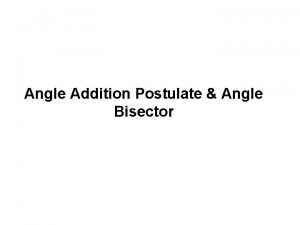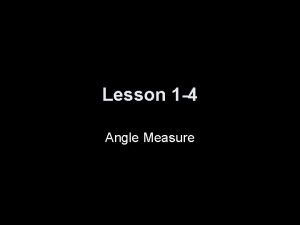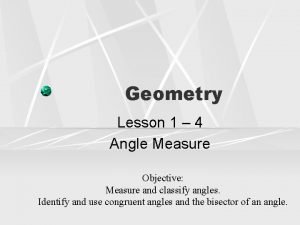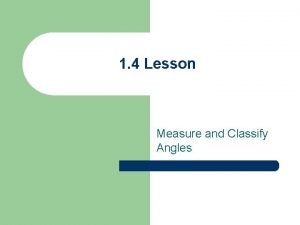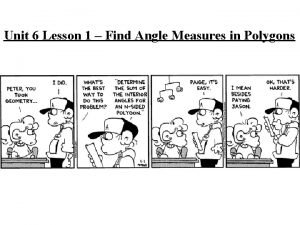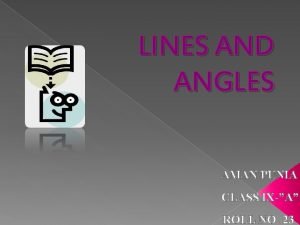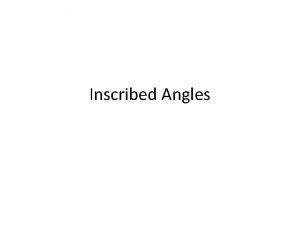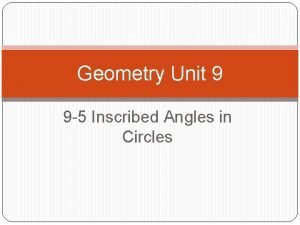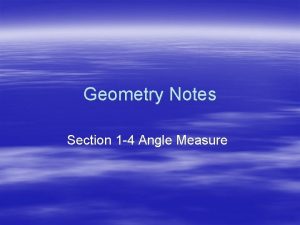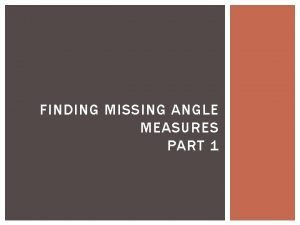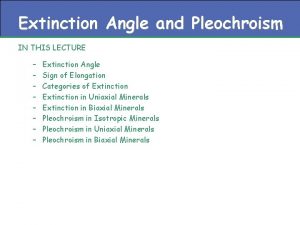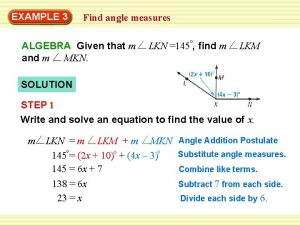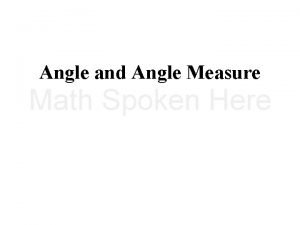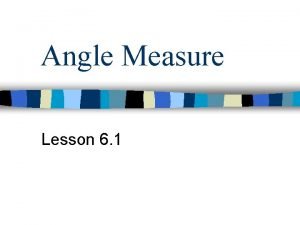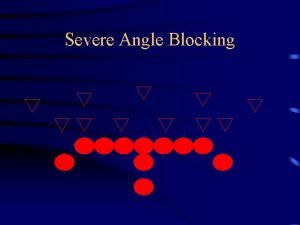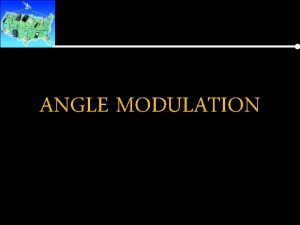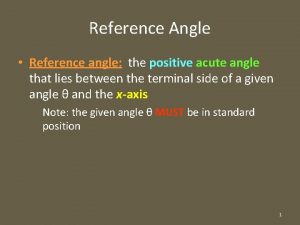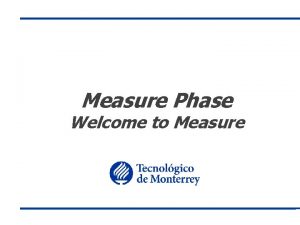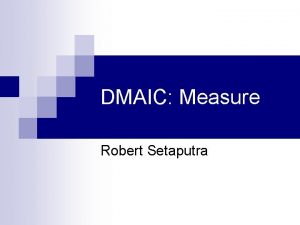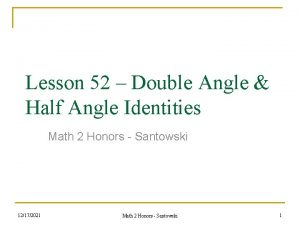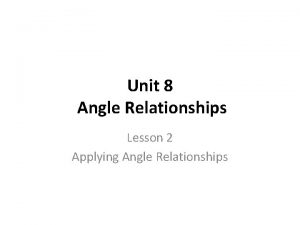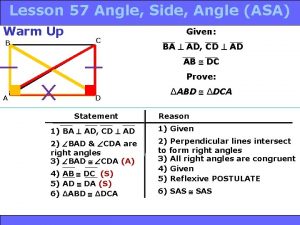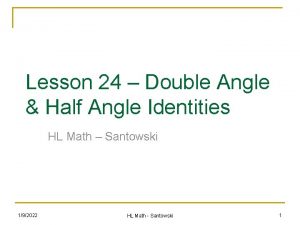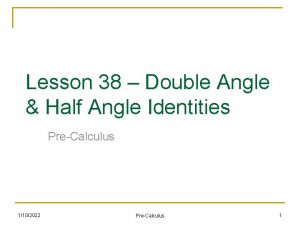Lesson 1 4 Angle Measure Transparency 1 4














- Slides: 14

Lesson 1 -4 Angle Measure

Transparency 1 -4 5 -Minute Check on Lesson 1 -3 Use the number line to find each measure. 1. AC D -4 2. DE -2 A 0 E C 2 4 6 3. Find the midpoint of EG 8 D 10 E F G H 4. Find the distance between P (-2, 5) and Q (4, -3). 5. Find the coordinates of R, if M (-4, 5) is the midpoint of RS and S has coordinates of (0, -10)? 6. What is the perimeter of ∆ DEF if its vertices are D(-2, -6), E(-2, 6), and F(3, -6)? Standardized Test Practice: A 12 units B 13 units C 17 units Click the mouse button or press the Space Bar to display the answers. D 30 units

Transparency 1 -4 5 -Minute Check on Lesson 1 -3 Use the number line to find each measure. 1. AC 4 2. DE 9 D -4 3. Find the midpoint of EG -2 A 0 E C 2 4 6 F 8 D 10 E F G H 4. Find the distance between P (-2, 5) and Q (4, -3). 10 5. Find the coordinates of R, if M (-4, 5) is the midpoint of RS and S has coordinates of (0, -10)? (-8, 20) 6. What is the perimeter of ∆ DEF if its vertices are D(-2, -6), E(-2, 6), and F(3, -6)? Standardized Test Practice: A 12 units B 13 units C 17 units Click the mouse button or press the Space Bar to display the answers. D 30 units

Objectives • Measure and classify angles • Identify and use congruent angles and the bisector of an angle

Vocabulary • Degree – one three hundred and sixtieth of a circle • Ray – part of a line with one end point • Opposite rays – are collinear rays with the same end point (& form a 180 degree angle) Angle is formed by 2 noncollinear rays with a common endpoint (vertex) • Sides – composed of rays • Vertex – is the common endpoint • Interior – area between the two rays that form the angle • Exterior – area not between the two rays that form the angle

Vocabulary (cont) Special types of angles: • Right angle – measure equals 90 degrees • Acute angle – measure is less than 90 degrees • Obtuse angle – measure is greater than 90 degrees (but less than 180) • Angle Bisector – a ray that divides an angle into two congruent angles

Angles Exterior of angle A R Vertex (hinge point) 360º A V ay Circle Interior of angle AVB Ray VB B Angles measured in degrees A degree is 1/360 th around a circle Acute A m A < 90º Right Obtuse A A m A = 90º < m A < 180º

Name all angles that have B as a vertex. Answer: 5, 6, 7, and ABG Name the sides of 5. Answer: and or are the sides of 5. Write another name for 6. Answer: EBD, FBD, DBF, and DBE are other names for 6.

a. Name all angles that have X as a vertex. Answer: 1, 2, 3, and RXB or RXN b. Name the sides of 3. Answer: c. Write another name for 3. Answer: AXB, AXN, NXA, BXA

Measure TYV and classify it as right, acute, or obtuse. TYV is marked with a right angle symbol, so measuring is not necessary. Answer: is a right angle.

Measure WYT and classify it as right, acute, or obtuse. Use a protractor to find that. Answer: > is an obtuse angle.

With lines ZE and CX and ray ZD, measure each angle named and classify it as right, acute, or obtuse. a. CZD Answer: 150, obtuse E D b. CZE X C Answer: 90, right c. DZX Answer: 30, acute Z

SIGNS A railroad crossing sign forms congruent angles. In the figure, WVX = ZVY. If m WVX =7 a + 13 and m ZVY =10 a – 20, find the actual measurements of WVX and ZVY. WVX ZVY 7 a + 13 = 10 a – 20 7 a + 33 = 10 a 33 = 3 a 11 = a WVX = 7(11) + 13 = 90° Answer: Both WVX and ZVY measure 90°

Summary & Homework • Summary: – Angles are classified as acute, right, or obtuse according to their measure – An angle bisector is a ray that divides an angle into two congruent angles (halves) • Homework: pg 33 -35; 9, 11, 13, 14, 20, 24 -26, 50
 The angle addition postulate answer key
The angle addition postulate answer key 1-4 angle measure answer key
1-4 angle measure answer key 1-4 angle measure
1-4 angle measure Geometry lesson 1-4 angle measure answers
Geometry lesson 1-4 angle measure answers Is measure for measure a comedy
Is measure for measure a comedy Barometer
Barometer 360 n
360 n Measure of each exterior angle of a regular polygon
Measure of each exterior angle of a regular polygon What is the measure of angle ixa
What is the measure of angle ixa Measure of an inscribed angle
Measure of an inscribed angle Inscribed angles math lib answer key pdf
Inscribed angles math lib answer key pdf Angle measure definition
Angle measure definition What does x equal
What does x equal Parallel extinction mineralogy
Parallel extinction mineralogy Find the indicated angle measure
Find the indicated angle measure
